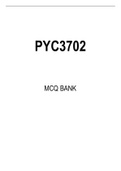PYC3702
MCQ BANK
,UNIVERSITY EXAMINATIONS
May/June 2020
PYC3702
Abnormal Behaviour and Mental Health
70 Marks
Duration 2 Hours
This paper consists of 23 pages.
Instructions:
Complete every question in this paper by choosing the most correct alternative for each
question. After completing your answers, you must submit these online. The answers to the
examination MCQ may only be submitted online. No other forms of submission is permitted.
Page 23 contains steps to submit your answers online using the “Assessment Info” tool on
MyUnisa. Please make sure that you verify your answers before you submit your responses.
Also print a copy of the Submission Report as your proof that you completed the exam.
Please remember that you have signed an Honesty Declaration when you downloaded this
paper. Any students who are found to contravene the UNISA assessment policy described
in the honesty declaration will undergo a disciplinary process that may lead to their
expulsion. Do not help other students and do not accept help from anybody else during this
exam.
Good luck.
CONFIDENTIAL
This examination paper remains the property of the University of South Africa and may not be
removed from the examination room.
[TURN OVER]
, CONFIDENTIAL
Page 2 of 23
PYC3702
May/June 2020
Question 1
Four major criteria are used to differentiate abnormal behaviour from normal behaviour. If a person
presented unusual behaviour with experiences of false perceptions of reality that were not culturally
accepted, it is an example of - - - - -.
1. distress
2. deviance
3. dysfunction
4. dangerousness
Question 2
As a mental health professional, ascertaining the possible causes for abnormal behaviour is a high
priority. This is known as identifying the - - - - - of the abnormal behaviour.
1. aetiology
2. prevalence
3. psychodiagnosis
4. psychopathology
Question 3
The Multipath Model associates - - - - - as a contributing factor from the - - - - - dimension when looking
at an individual’s development of Posttraumatic Stress Disorder (PTSD) in response to a traumatic event.
1. gender; biological
2. resilience; sociocultural
3. fear extinction; psychological
4. history of childhood maltreatment; social
[TURN OVER]
, CONFIDENTIAL
Page 3 of 23
PYC3702
May/June 2020
Question 4
One of your childhood friends, who is experiencing problems adjusting to university, has recently started
to drink heavily. You decide to apply the Multipath Model to understand the development of his behaviour.
You conclude that your friend’s coping skills and the friends that he lives with at his university residence,
who binge drink, are factors prompting his alcohol abuse.
Which two of the four dimensions that are included in the Multipath Model have you identified here?
1. Cognition and Learning
2. Psychological and Social
3. Biological and Sociocultural
4. Behavioural and Interpersonal
Question 5
Stressful environments during the years of childhood, that lack predictable parenting and nurturing, are
core characteristics of - - - - -, which is demonstrated by inhibited, emotionally withdrawn behaviour toward
the caregiver by the child.
1. Social Phobia
2. Autism Spectrum Disorder
3. Reactive Attachment Disorder
4. Disruptive Mood Dysregulation Disorder
Question 6
Intellectual Disability (ID) is highly heritable and characterised by significant limitations in intellectual
functioning and adaptive behaviours in children and adolescents. The most common inherited form of ID
is - - - - -.
1. Down syndrome
2. Tourette’s Disorder
3. Fragile X syndrome
4. Autism Spectrum Disorder
Read the following case study and answer questions 7, 8, 9 and 10.
Angela is a 45-year-old divorcee and mother to two daughters. She works full time as a sales
representative for an industrial equipment firm and would drive across Johannesburg every month in
order to meet her clients. During one of these trips, Angela and her colleague were involved in a
horrifying collision with a minibus-taxi in which several passengers died on the scene. Although neither
she nor her colleague were seriously injured in the incident, Angela now experiences severe attacks
of anxiety whenever she has to drive and avoids driving the same route where the collision occurred
which is negatively affecting her job performance.
In the six months since the accident, Angela has endured a persistent negative emotional state and
experiences difficulty sleeping. She blames the taxi driver for the accident, even though she admits to
not remembering important aspects of the event, and becomes angry and verbally aggressive towards
[TURN OVER]




